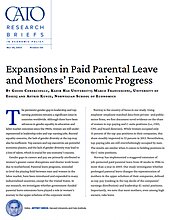Gender gaps in careers and pay are primarily attributed to women’s greater career disruptions and shorter work hours due to motherhood. Parental leave programs, intended to level the playing field between men and women in the labor market, have been introduced and expanded in many industrialized countries, except for the United States. In our research, we investigate whether government-funded parental leave extensions have played a role in women’s journey to the upper echelons of the corporate world.
Norway is the country of focus in our study. Using employer-employee matched data from private- and public-sector firms, we first document novel evidence on the share of women in top-paying and C‑suite positions (i.e., CEO, CFO, and board directors). While women occupied only 15 percent of the top-pay positions in their companies, this share steadily improved to 33 percent in 2013. Nevertheless, top-paying jobs are still overwhelmingly occupied by men. The results are similar when it comes to holding positions in the C‑suite positions.
Norway has implemented a staggered extension of job-protected paid parental leave from 18 weeks in 1986 to more than a year in 2005. Our study investigates whether prolonged parental leave changes the representation of mothers in the upper echelons of their companies, defined as top-pay (ranking in the top decile of the companies’ earnings distribution) and leadership (C‑suite) positions. Importantly, we note that most mothers, even among high earners, take leave.
To identify the impact of each parental leave expansion, we compare mothers giving birth just before and just after each of the eight reforms (i.e., mothers ineligible for the reformed leave policy versus those eligible). Our analysis reveals that extending parental leave duration neither helped nor hurt mothers’ career prospects. The effect of each expansion on mothers’ likelihood of ranking within the top decile of their firm’s pay distribution is indistinguishable from zero. Since one may argue that it takes time to attain these top positions, we follow mothers up to a quarter of a century after childbirth and show that the leave extensions did not have any short‑, medium‑, or long-term effects. Likewise, the expansions did not influence the likelihood of mothers advancing to the C‑suite or holding managerial positions in their firms. These null results hold even if we consider the first six expansions as one large expansion of maternity leave or estimate a cumulative effect of the incremental maternity leave duration expansions.
In addition, our study expands on the current literature by conducting a thorough examination of various channels associated with skill level and job mobility, including work experience, tenure at a company, working hours, internal promotions, and firm-to-firm transitions. We investigate whether any of these channels potentially explain the null effects observed. Our findings demonstrate that the causal effects remain negligible for all channels we analyze throughout the entire post-birth period. We also show that the increased maternity leave had no differing effects along several dimensions, including education, number of children, firm size, and industry.
Among the eight reforms we analyze, the 1993 reform introduces a paternity quota, and the 2005 reform extends the paternity quota. The 1993 reform induced a dramatic increase from 3 to 38 percent in the leave take-up of fathers. Yet, we find null effects of the 1993 paternal quota and the 2005 expansion on the fathers’ likelihood to be in the upper earnings decile or the C‑suite of their companies. Moreover, we detect no spillovers from either maternity leave extensions to the fathers’ top career outcomes or from paternity leave to the mothers’ top career outcomes.
There is scant evidence regarding how parental leave mandates affect the pay gap between mothers and their male coworkers as well as between mothers and their partners. Our results indicate that none of the eight reforms contributed to the decline in wage gaps that we document within firms between mothers and their male coworkers. This null result holds true whether we only consider women in the upper decile of their companies’ earnings distribution or mothers across the entire income distribution. The reforms also did not alter the gender pay gaps between mothers holding a top position and their partners.
Overall, we find robust evidence that government-mandated paid parental leave programs had no effect on mothers’ economic status in the short, medium, or long term, either at the top of their companies or within their households. In the case of Norway, the absence of effects may be attributed to the gradual implementation of the parental leave program, which possibly allowed companies to gradually adjust to leave extensions. However, it is worth noting that the results cannot be explained by a low parental leave take-up rate, as we show that it is close to 100 percent even among high earning mothers.
NOTE
This research brief is based on Gozde Corekcioglu, Marco Francesconi, and Astrid Kunze, “Expansions in Paid Parental Leave and Mothers’ Economic Progress,” Center for Economic Studies and Ifo Institute for Economic Research Working Paper no. 10028, October 2022.

